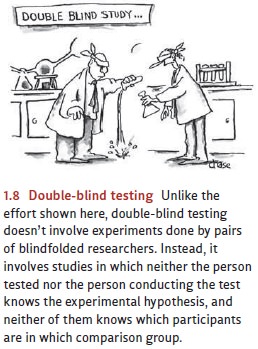Chapter: Psychology: Research Methods
Making Observations: Monitoring Demand Characteristics
Monitoring
Demand Characteristics
External validity also depends on
another consideration: We need to make sure that our study itself doesn’t
affect the behaviors we hope to examine. One concern here is that people’s
behavior sometimes changes when they know they’re being observed. They may be
trying to present themselves in the best possible light, or maybe they’re just
feel-ing self-conscious about being observed and act differently as a result.
A study’s demand characteristics can also alter people’s behavior. This term
refers to any cues in a situation that make participants think one response is
more desir-able than another. Sometimes the demand characteristics are
communicated in the way questions are phrased (“You do brush your teeth every
morning, don’t you?”). Sometimes they’re conveyed more subtly—perhaps without
realizing it, the investi-gator smiles and is more encouraging when the
participants answer in one way rather than another.
In some studies, demand
characteristics influence an entire data pattern. For exam-ple, how often do
people drive their cars through red lights? To find out, we might col-lect
responses on a questionnaire that asks people directly about their driving
habits. (“In the last month, how often have you . . .”) But the results from
this study would surely underestimate the frequency of this traffic violation:
we’re asking about an ille-gal activity, so people are likely to give us a less
candid but more “desirable” response (“I never
run red lights.”).
In other cases, demand
characteristics can create artificial differences between the groups being
compared. Imagine that an investigator is comparing the problem-solv-ing skills
of American and Japanese students, but he’s warmer and more encouraging to the
Japanese participants than to the Americans. In this situation, any differences
we observe between the groups might be due to the students’ country of origin,
or they might be due to this differential treatment. Because of this ambiguity,
we could draw no conclusions from these data.
Investigators take several steps
to minimize a study’s demand characteristics. First, they try to phrase
questions and instructions as neutrally as possible, so that partici-pants
can’t identify any response as preferred or “better.” If questions are likely
to be embarrassing or provoke anxiety, the investigators do everything possible
to diminish these concerns and guarantee that all information gained from the
participant will remain confidential. Investigators are also careful to treat
all study participants alike. In many studies this equal treatment is
guaranteed by the use of a double-blind
design, in which neither the person who actually collects the data nor the
study participants themselves know the nature of the hypotheses at stake—or, in
some studies, the nature of the groups being compared (Figure 1.8). This
approach ensures that the investigators treat the various groups of
participants alike and that participants in the various groups have similar
expectations about the procedure.

Related Topics